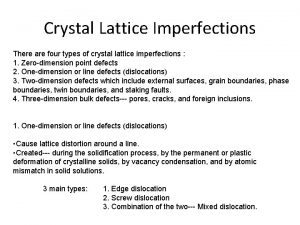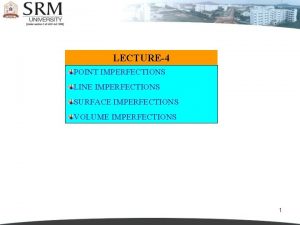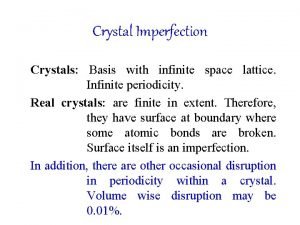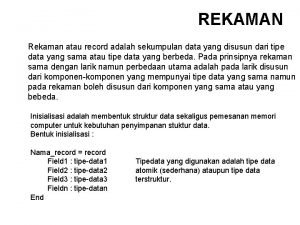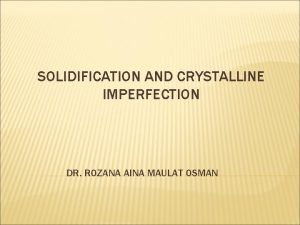II Market Structure 2 Market Imperfection II Market













- Slides: 13

II. Market Structure: 2. Market Imperfection

II. Market Structure 2. Market Imperfection -(1). Market Imperfection – Basic Concept -(2). Categories of Markets -(3). Degrees and Concepts of Partial Competition -i. Ineffective Competition: Competition -(i). Monopoly -(ii). The Dominant Firm -(iii). Tight Oligopoly ii. Effective Competition : -(i). Loose Oligopoly -(ii). Monopolistic Competition -(iii). Pure Competition

III. Market Structure: 2. Market Imperfection -(1). Market Imperfection- Basic Concepts -i. Perfect competition involves pure competition in which -1. there a large number of buyers an sellers of -2. homogeneous product with -3. no obstacles to entry or exit of firms plus certain strict assumptions, as follows: -4. perfect knowledge, -5. perfect mobility, -6. rational behavior, -7. no nonmarket interdepenences, -8. market is always clear.

III. Market Structure: 2. Market Imperfection -(1). Market Imperfection – Basic Concepts -ii. Categories of Market Imperfections: -1. Barriers Against New Competition – 3 -2. Consumer Loyalties May Exist – 2 -3. Differences in Access to Information, Including Secrecy – 4 -4. There May Be Large Uncertainties – 4 -8 -5. Risk Aversion – less competitive - 6 -6. Transactions Costs May Be Significant – 4 -8 -7. Consumers May Exhibit Irrational Behavior – 6 : :

III. Market Structure: 2. Market Imperfection -(2). Categories of Markets Ineffective Competition: Competition i. Monopoly ii. The Dominant Firm iii. Tight Oligopoly Effective Competition: Competition i. Loose Oligopoly ii. Monopolistic Competition iii. Pure Competition

III. Market Structure: 2. Market Imperfection -(3). Degrees and Concepts of Partial Competition -i. Ineffective Competition: -(i). Monopoly MR = MC Pm>Pc Qm<Qc Pm>MC Consumer surplus -i. X-Inefficiency -ii. Misallocation -iii. Redistribution -iv. Invention and Innovation -v. Freedom of choice -vi. Democracy -vii. Culture and Society

III. Market Structure: 2. Market Imperfection -(3). Degrees and Concepts of Partial Competition -i. Ineffective Competition: -(ii). The Dominant Firm: its power over the market is less than complete. A. Schumpeter’s Competitive Process: Transient Dominance? An process of dynamic disequilibrium: competition and progress occur together, i. e. , the cycle of creative destruction continues. ( the exact reverse of the neoclassical analysis of monopoly ) ↑ Passive Dominant Firms ? ? ? ( Be vulnerable enough? Easy entry? Max LRπ? ) B. * Dominance is usually ineffective competition. Persistent Dominance: i. Higher prices, ii. Price discrimination.

-(3). Degrees and Concepts of Partial Competition -i. Ineffective Competition: -(ii). Dominant Firm

III. Market Structure: 2. Market Imperfection -(3). Degrees and Concepts of Partial Competition -i. Ineffective Competition: -(iii). * Tight Oligopoly: ◎ The collusion is likely. main lines of the topic are as follows: i. Oligopoly is about fewness and interdependence ii. There is indeterminancy. iii. Strategy is required. iv. Oligopoly also means a wide range of outcomes. v. The oligopolists always have mixed, conflicting incentives between competing and colluding.

III. Market Structure: 2. Market Imperfection -(3). Degrees and Concepts of Partial Competition -i. Ineffective Competition: -(iii). * Tight Oligopoly: ◎ collusion is likely. Conditions facilitae coordination: i. High Concentration. iii. Familiarity over time. ii. Similarity of the Firms’ Conditions. ◎ Types of Coordination: i. Cartel. ii. Tacit Collusion.

III. Market Structure: 2. Market Imperfection -(3). Degrees and Concepts of Partial Competition -i. Ineffective Competition: Tight Oligopoly -(iii).

III. Market Structure: 2. Market Imperfection -(3). Degrees and Concepts of Partial Competition -ii. Effective Competition: -(i). Loose Oligopoly : collusion is not likely. -(ii). Monopolistic Competition Each firm has a slight degree of monopoly power, as follows: i. There is some product differentiation ii. There is free entry. iii. There is no interdependence among individual firms. -(iii). Pure Competition

III. Market Structure: 2. Market Imperfection -(3). Degrees and Concepts of Partial Competition
 Lattice imperfections
Lattice imperfections Volume imperfections
Volume imperfections Crystal imperfection
Crystal imperfection Market leader challenger follower nicher examples
Market leader challenger follower nicher examples Market segmentation target and positioning
Market segmentation target and positioning Giant molecular structure vs simple molecular structure
Giant molecular structure vs simple molecular structure Giant molecular structure vs simple molecular structure
Giant molecular structure vs simple molecular structure Lexical ambiguity examples
Lexical ambiguity examples Linguistics
Linguistics Surface and deep structure
Surface and deep structure Giant molecular structure vs simple molecular structure
Giant molecular structure vs simple molecular structure What is static and dynamic data structure
What is static and dynamic data structure Yang merupakan pengertian dari rekaman data adalah
Yang merupakan pengertian dari rekaman data adalah
